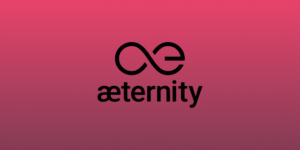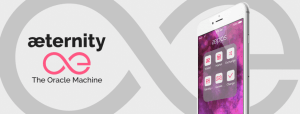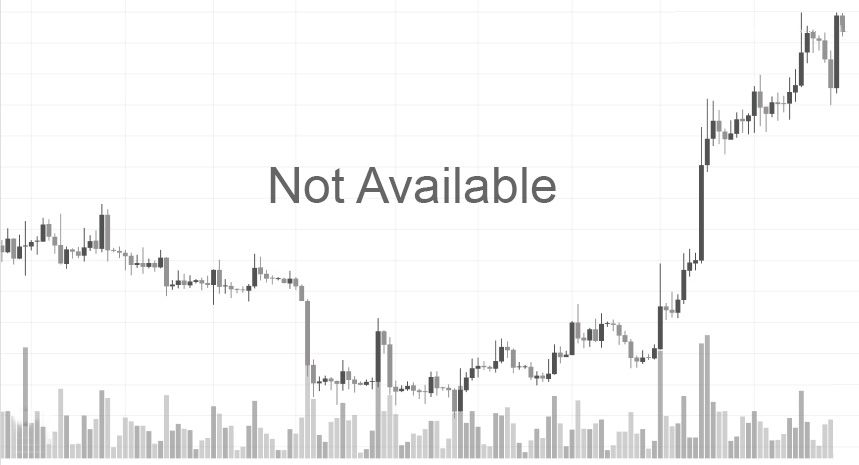Aeternity is an open source blockchain platform trying to improve what blockchain can offer in terms of smart contract and dapp (decentralized app) scalability. It implements state channel technology with a focus on external data sources relating to smart contracts.

The Aeternity platform was launched in 2017 as a smart contract and dapps platform focused on correcting what its designers identified as scalability-related problems faced by these technologies. Upon the launch of its testnet and the Aeternity token back in 2017, the Aeternity project garnered enough attention of the crypto community to have it rank among the top 40 currencies by market capitalization as of November 2018. Its future, however, will arguably depend on what it manages to deliver on its promise to increase the scalability of smart contracts, connect them with the external data sources and reduce the mining requirements.
In order to achieve this, Aeternity plays the card of implementing an array of different technologies working towards its stated goals. These are its state channel technology as a solution for the scalability problem, a hybrid consensus model combining the Proof of Work and Proof of Stake systems and a decentralized oracle-based system tasked with connecting real-world data with smart contracts. Let’s see how these work at individual level and which specific issues they aim to tackle.
Smart Contract Scaling Problem Aeternity Wants to Bypass
Scalability is the issue that has plagued the blockchain since the outset and it only became more pronounced with its increased adoption. In the context of smart contracts, scalability refers to the ability of this technology to handle the growth in the number of its users and manage to offer satisfactory efficiency in the face of increased demand.
Take, for example, Ethereum platform which uses its blockchain to allow for the development and deployment of smart contracts. In its current version, each smart contract on the platform is assigned to each full node. If users want to interact with their smart contracts, these programs are executed on every full node they are deployed to and this happens throughout the network. The issue came to prominence with the increasing traffic rates on the network which went in parallel with the rising popularity of this platform. Not too long ago, Ethereum faced a network-wide slowdown brought about by a simple game involving breeding of virtual pets, CryptoKitties.
As the Ethereum blockchain developed, the size of its blocks grew in parallel. The reason for this lies with its architecture i.e. the fact that Ethereum runs on the node network, with each of them storing information on the whole of transaction history as well as the data on the state of smart contracts and account balances. Considering that the number of transactions rises with each new block in the interval of 10 to 12 seconds, it is easy to see how this limitation made the management and handling of transactions and smart contracts an increasingly complex and prolonged process which could take hours. The pool of users often includes businesses that carry out their transaction on the Ethereum network whose blockchain is also the home to various cryptocurrencies. Put together, all of these factors contributed to the drop in the transaction processing rates on the Ethereum blockchain which, in turn, endangered its capability to scale together with an increasing number of its users. At the same time, the same users increasingly demand at least the same level of functionality and efficiency they became used to when using popular online payment processing systems.
Aeternity Moves Smart Contracts Off Chain
Initially, blockchain platforms tried to approach the problem of scalability by increasing the sizes of blocks on their networks. The goal was to allow for the execution of the higher number of transactions per second on each block, based on the knowledge that time period needed for block verification is largely dependent on the complexity of cryptographic computations involved in it. Yet, there were some issues with this approach. Making the blocks larger in order to have them handle more transactions meant putting more demands on the mining resources one needs to have to manage them. The centralization of power as a byproduct of this would mean the removal of the users who can verify transactions from the network, leaving the enlarged blocks in the few hands of large players (such as companies) that have sufficient resources to actually run them.
Instead of this, Aeternity platform opts for moving smart contracts off its blockchain and having them executed with the help of the state channel technology. This technology involves the use of the communication channels which run between the contracting parties. State channels are run off the Aeternity’s blockchain, meaning that they do not get involved with it, except in the cases which entail the need for the resolution of disputes or transfers of value. In case of disagreements related to smart contracts, the problems which need adjudication are handled by using the main blockchain to send the announcement on the last known commonly agreed interaction which took place off-chain. At the same time, the blockchain is invited to pass the judgment related to the contested issue, acting as an equivalent of an impartial judicial authority. This is further ensured by using the zero-knowledge proof method in relation to the contents of the smart contract in question, thus protecting its privacy.
The procedure ends with the settlement and the closing of the contract which are both handled on the chain. Since all other procedures related to smart contracts are managed off-chain, the throughput capacity of the Aeternity remains largely unaffected by these standard operations.
At the same time, transactions themselves are processed in more expeditious manner since they do not take place on the blockchain. The state channels take care of the management of fast micropayment transactions, bringing down their cost and the drain on resources. The reason for this is the fact that only the parties to a smart contract or those who are involved in the transfer or value actually have access to the information on the particular transactions which take place between them. In addition to avoiding the burdening of the network resources with unneeded information, this approach also improves the level of privacy offered to the contracting parties. This is particularly important for corporations whose smart contract can contain confidential business data, as well as for regular users who need to manage their sensitive information on the Aeternity platform.
Aeternity Applies Functional Approach to Smart Contract Development
Moving the communication segment of the smart contract management off the chain does not mean that Aeternity will have easier time facing what its competitors offer as their solutions to the problem of scalability. Zilliqa, for example, opts for the implementation of the sharding technology as a response to this issue. Some of competitors such as Decred employ seemingly similar approach in handling transactions on tis network off-chain (via micropayment channels). Aeternity’s competitor Ethereum focuses on stateful programming as the basis for the development of smart contract applications.
“Stateful” here means that its platform will keep tabs on what happens with interactions relating to smart contracts (their “state”), as opposed to the “stateless” approach which keeps no evidence of earlier interactions. In case of Aeternity, its “functional” approach means that only the contracting parties remain in charge of the state of their contract, in the sense that they create inputs for it and validate them upon their execution. In separating the stateful from the functional programming, Aeternity hopes to improve the smart contract scalability, while allowing for their easier coding and storage with the help of the Chalang language which is optimized for the state channels on blockchain.
Aeternity also competes with others as the decentralized application platform. Its dapps are called “aepps” and these are being developed as open source creations which serve as a preview of what the Aeternity platform is capable of ahead of the launch of its mainnet. Aepps developed on Aeternity focus on a mobile-first approach and streamlined mobile-desktop connection as part of the platform’s aim to drive its adoption based on broader accessibility.

Aeternity’s Oracle Machine
Smart contracts built on the Aeternity platform are not designed to become closed or isolated systems. Instead of this, Aeternity provides technology which will allow them to receive inputs from the outside world. These can take the form of external data which can be relevant for the execution of a smart contract. The examples include checking the information on the prices of various products or goods, monitoring election results or keeping up to date with the weather conditions.
To that effect, Aeternity integrates oracles as agents that identify real-world events and forward information on them to the blockchain the smart contracts exist on. Machine oracles act as sensors that gather and forward digital information in the format which smart contracts can read, while user oracles confirm the veracity of these information or report their own data. Each user can ask questions related to what happens in the “external world” of smart contracts and the oracles provides them with an answer. Aeternity also uses prediction market protocol which allows users to bet on the incoming data the oracles provide.
Since the oracles can request and be given access to the external data sources, they can pose a security risk to the blockchain and become a vulnerable point because of their central status in the data management. Aeternity attempts to avoid this pitfall by making the information contained in the oracle data feeds immutable as soon as they arrive on the Aeternity platform.
Hybrid Consensus Model
To make centralized data streams such as oracles less of a security problem, it is also necessary to determine if the facts they supply are “true” or “false”. At the same time, malicious attacks can make the data sources give false values, making it necessary to implement a consensus mechanism that checks the oracles and activates in case there is a disagreement. In order to achieve this, Aeternity implemented a hybrid proof of work and proof of stake consensus mechanism on its platform. Proof of work handles the consensus on the platform while the proof of stake manages the governance. While those who mine the AE coins verify new blocks based on the PoW system, Aeternity has implemented its Cuckoo Cycle variant which allows for better scalability in terms of dynamic RAM requirements of the system. The algorithm also offers better energy efficiency and instant verification. All of this points to Aeternity’s ambition to streamline mining on easily available devices such as mobile phones in the future. Owners of the AE tokens use these as proportionate stakes based on which they vote on proposals to change and further develop the platform.
AE Token Availability
As the Aeternity is still in the testnet stage (as of November 2018), its Aeon token was launched as an ERC-20 token running on Ethereum. After the launch of the mainnet, these tokens will be exchanged for Aeternity coins. The tokens are used to pay the fees for transactions which take place on the Aeternity platform as well for the settlement of its smart contracts, similar to Ethereum’s gas.
The initial coin offering (ICO) for the AE took place in mid-2017 and it eventually raised USD 24 million. The coin’s current market cap (November 2018) stands at USD 280 million, down from its historic high of just over one billion USD in May 2018. The number of tokens in circulation is 233,020,472 AE. The tokens are available for trading on crypto exchanges such as HitBTC.
The Team behind Aeternity
The Aeternity project is based in Lichtenstein. The CEO and founder of Aeternity is Yanislav Malahov who describes himself as the godfather of Ethereum due to his early collaboration with Vitalik Buterin, co-founder of Ethereum. The Aeternity team has grown since its inception and it now comprises more than 40 individuals with backgrounds in blockchain, Erlang programming and business development.
The Aeternity Starfleet is the set of business incubator and investment programs organized as part of the Aeternity project in order to stimulate development of the platform and the blockchain in general.
